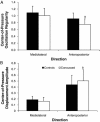Persistent motor system abnormalities in formerly concussed athletes
- PMID: 21669091
- PMCID: PMC3419550
- DOI: 10.4085/1062-6050-46.3.234
Persistent motor system abnormalities in formerly concussed athletes
Abstract
Context: The known detrimental effects of sport concussions on motor system function include balance problems, slowed motor execution, and abnormal motor cortex excitability.
Objective: To assess whether these concussion-related alterations of motor system function are still evident in collegiate football players who sustained concussions but returned to competition more than 9 months before testing.
Design: Case-control study.
Setting: University laboratory.
Patients or other participants: A group of 21 active, university-level football players who had experienced concussions was compared with 15 university football players who had not sustained concussions.
Intervention(s): A force platform was used to assess center-of-pressure (COP) displacement and COP oscillation regularity (approximate entropy) as measures of postural stability in the upright position. A rapid alternating-movement task was also used to assess motor execution speed. Transcranial magnetic stimulation over the motor cortex was used to measure long-interval intracortical inhibition and the cortical silent period, presumably reflecting y-aminobutyric acid subtype B receptor-mediated intracortical inhibition.
Main outcome measure(s): COP displacement and oscillation regularity, motor execution speed, long-interval intracortical inhibition, cortical silent period.
Results: Relative to controls, previously concussed athletes showed persistently lower COP oscillation randomness, normal performance on a rapid alternating-movement task, and more M1 intracortical inhibition that was related to the number of previous concussions.
Conclusions: Sport concussions were associated with pervasive changes in postural control and more M1 intracortical inhibition, providing neurophysiologic and behavioral evidence of lasting, subclinical changes in motor system integrity in concussed athletes.
Figures


References
-
- Kelly JP. Traumatic brain injury and concussion in sports. JAMA. 1999;282(10):989–991. - PubMed
-
- McCrea M, Guskiewicz KM, Marshall SW. Acute effects and recovery time following concussion in collegiate football players: the NCAA Concussion Study. JAMA. 2003;290(19):2556–2563. et al. - PubMed
-
- Cavanaugh JT, Guskiewicz KM, Stergiou N. A nonlinear dynamic approach for evaluating postural control: new directions for the management of sport-related cerebral concussion. Sports Med. 2005;35(11):935–950. - PubMed
MeSH terms
LinkOut - more resources
Full Text Sources
Medical

